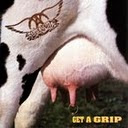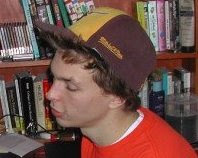When I was eleven years old I ripped one of those Columbia House ads from a magazine (you know the ad, it advertised ten CDs for a penny) and spent a good two hours picking out which CDs (the paper itself was covered in titles on both sides, and you got to check ten of them) to get. At this time I did not own a CD player. I had saved relentlessly for a Walkman a year before or so and dubbed two of my dad's albums onto tape: Jimi Hendrix's Are You Experienced? and Cream's Strange Brew (which was in fact a greatest hits collection).
So my first ten CDs all came at once, in the biggest box I had probably ever received in the mail. If I could reach back from the future and guide the choosing hand of my eleven-year old self I would certainly make some changes, but for better or for worse, here's what they were:
Aerosmith: Get A Grip

For some reason at this age I was convinced that Aerosmith was the coolest band in the world. I think it was the song "Livin' On The Edge" from this album with its doomsday lyrics and insane length. I also liked to point out the line "if you can tell a wise man by the color of his skin, then mister you're a better man that I," apparently thinking that was the epitome of artistic social commentary. Unfortunately this album isn't very good. All the songs sound like Aerosmith 101 and where they attempt social commentary it falls quite flat. "Eat the Rich" is all about how much they hate rich people, which seems hypocritical at best for an uber-platinum-for-three-decades-straight arena rock band. Still, this album did introduce me to the word "psychedelic," when Steve Tyler yells "psychedelic sandwich!!!" on "Gotta Love It." I asked my dad what it meant and he showed me a heavily altered kaleidoscope picture of the Beatles.
Aerosmith: Pump
Like a lost puppy, I didn't know what to check next so I just checked two Aerosmith albums. This one is probably stronger than Get a Grip but I listened to it less, probably because the other one was newer. The only song I really remember from it is Janie's Got a Gun, which I dug hard because of the drum fills made to sound like thundering gunshots.
Eric Clapton: Timepieces
This is just a greatest hits album of Clapton's solo work and as such is mostly the sappy kind of "After Midnight," "Wonderful Tonight," "Cocaine" pop songs more than the acidic blues-rock he did with Cream. It did include "Layla," though, which up to that point I had only heard on the Unplugged album. I could barely believe they were the same song. I put the original on at least three different mixtapes that year.
Red Hot Chili Peppers: What Hits?I
Well. Time to get to the good stuff. I liked the Chili Peppers' name, and had heard "Give It Away" at some point and knew they were the shit. But I didn't realize to what extent. This is a best-of, but it focuses entirely on their 80's output with the sole exception of "Under The Bridge." At various times "Fight Like a Brave," "Knock Me Down," Taste the Pain," "Show Me Your Soul," and "Under The Bridge" became my favorite songs, and they all deserved it. Anyone who hasn't heard the eighties version of the Peppers is missing out bigtime. They had a wild energy of a flavor that no one else could touch, and that they couldn't possibly keep up into their late 30s, so they later dialed up the Keidis balladry and put the funk on hold. I recommend this album as a starter, then Mothers' Milk, and if you still feel like going from there the rest of their stuff is crazy ill too.
Jimi Hendrix: The Ultimate Experience
Yet another greatest hits package. I don't think I realized that was what I was getting at first, but when all four songs at the top were from Are You Experienced? I must have gotten wise. It also contained highlights from the other two Experience albums, as well as a bunch of unreleased stuff, the divine "Angel," and his two most famous live performances, "Wild Thing" (where he burns his guitar at the end) and "Star Spangled Banner." For some reason there is no Band of Gypsys material on this album. I was already a Hendrix fan but this made me a fanatic, and by the end of the year I had all the Experience albums, the Band of Gypsys concert, and a bunch of random posthumous crap to boot.
Michael Jackson: Thriller
I bought this one on the logic that the best-selling album of all time couldn't possibly be bad. Unfortunately, the first thing I noticed on it was the novelty of having Paul McCartney on a song ("The Girl Is Mine," as if you didn't know) and that was the song I first put on a mixtape. I had some friends over at my house and it came on and they looked at me like "Michael Jackson? Really?" and I got embarrassed and hid the album for years. I gave it a tenuous respect at arms'-length for a while, even putting "Thriller" (the song) on a mixtape or two, but it wasn't until late high school that it dawned on me what a dance-floor dynamite some of these songs were. By college I had realized that nothing, anywhere, ever, can light up a dancefloor like "Billie Jean," and my original copy still sits in my dusty CD collection, albeit missing the front of the jewel box.
Nas: Illmatic
To buy this album was totally out of character for me. I didn't really like rap (or thought I didn't) and wasn't allowed to get stuff with explicit lyrics labels. But this was a new release so the Columbia House pullout actually showed its cover as a featured album. The dark urban landscape and child's face juxtaposed on the cover was intriguing and bizarre to my young self, and the words "Nas" and "Illmatic" were different from any other words I'd ever heard, in a spellbinding way. I snuck it past my parents somehow, and listened to it only in headphones, and it engulfed me. It sounded absolutely unlike any rap music I had ever heard. At the time the national spotlight was all over Snoop Dogg and Ice Cube, criticizing them for making music that glorified violence and misogyny and turned them into a party. Illmatic's music was somewhere between melancholy and menacing, definitely not made with a dance party in mind. Nas's lyrics came "Straight out the fuckin dungeons of rap," and as vivid as his imagery was, it seemed real and immediate, not cartoonish like Snoop Dogg. Also, I got the distinct impression that Nas was not trying to glorify violence but rather to paint a picture. There was a strong theme of using poetry and art to rise above horrible conditions, and not just in terms of money but in terms of art itself. I really didn't fully appreciate this album at the time, partly because my ear wasn't attuned to complicated rap lyrics, and also because my lack of knowledge of the scene kept me from being able to find anything comparable (in terms of lyrics or production) until several years later. I only listened to it a few times that year, but it planted the seed and by the time I was fifteen or so I listened to underground hip hop almost exclusively. I've thought a lot in terms of top five lists and things like that over the years, and I'm pretty sure I would call this the greatest hip hop album ever recorded. Strangely it was almost pure coincidence that it was also the first one I ever owned.
Stone Free: A Tribute to Jimi Hendrix
This tribute album featured wall-to-wall Hendrix covers by the likes of the Cure, PM Dawn, and Temple of the Dog. I didn't really like it and I sold it to a record store within a couple months of buying it. I might like it better if I heard it now, but I kind of doubt it.
I cannot for the life of me remember what the last two albums were. I'd love to say they were Hot Rats and Paul's Boutique, but I'd be lying.



